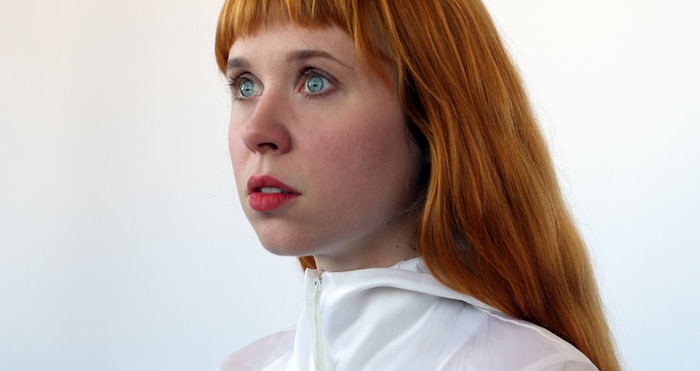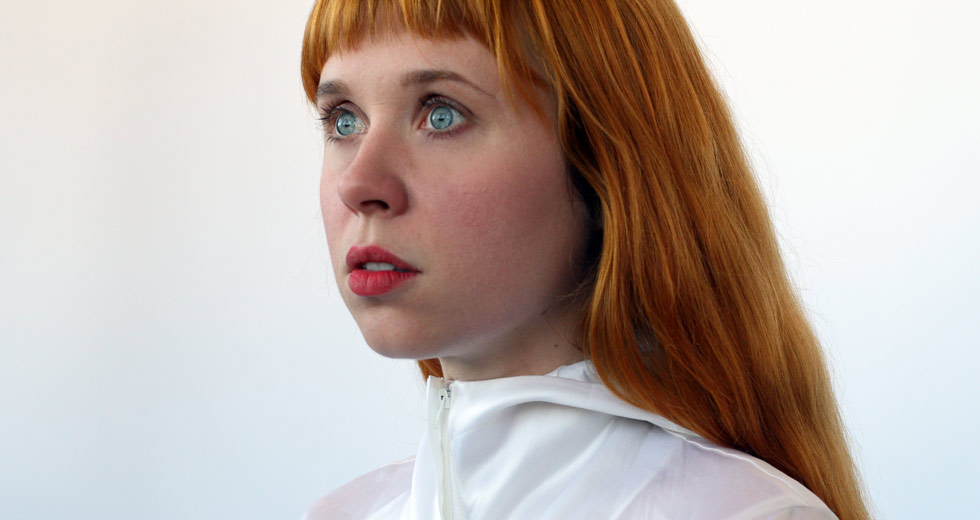Computer Love: An Interview With Holly Herndon
Holly Herndon was raised in Tennessee, but cut her teeth in Berlin, going on to earn her stripes in American music academia; she is currently a doctoral candidate in composition at Stanford University. Since finding her voice through the medium of her laptop, she has collaborated with the likes of Hieroglyphic Being, footwork producer Jlin, Iranian philosopher Reza Negarestani and has just released her new album Movement via New York’s RVNG Intl. Steph Kretowicz gets the inside scoop.

“What is it 1980? Loser! Why don’t you join the 21st century already?” So says a disembodied voice broken free from a stock seatbelt safety message on Holly Herndon’s 2011 cassette release Car. A crunching, discordant crawl through a collision of distorted engine drones, FM static and garbled windshield wiper sounds, the 48-minute track is hardly an easy listen. Yet, this is electronic artist Herndon confronting her audience in the space they’re most likely to have a tape player – the car.
As a doctoral candidate in composition at Stanford University, with an MFA from Oakland’s Mills College, Herndon’s is a focus on reach: bridging the gap between audience and academia. But this year, rather than invading a private space and bullying said listener into joining the rapid current of progress, Herndon is applying her intellectual pursuits to a more accessible and comparatively delicate mode of interaction. Her debut album, Movement, is coming out on influential New York label RVNG Intl and presents Herndon’s voice in all its manipulated and distorted incarnations. There’s the choppy glottal stammer of “Terminal”, the fragmented, bestial contortions of “Interlude” and those vacillating vocal shifts of closer “Dilato” that sounds exactly like a man’s… “Oh no, sorry, that’s Bruce [Rameker],” Herndon says laughing, “he’s a baritone.”
Aside from the aforementioned closer, the voice on the rest of the album is “99.9 per cent mine,” Herndon assures me in a chat across time zones, through an ever-unreliable Skype connection. It’s a slightly scrambled discourse punctured by the occasional, “all of that was just digital stuttering,” but the significance of such a conversation isn’t lost on anybody. Especially when you consider Herndon’s own preoccupation with vocal processing and what she calls “embodied computer music,” courtesy of her laptop. “I think the point is, with these tools, you can have the power to transcend whatever your current status is, and that’s what I’m interested in.”
But Herndon hasn’t always been so progressive. Born in the 80s, raised in North-east Tennessee and virtually cut off from the expanding internet universe until her last year of high school, it was initially a slow ascent to her present position at the cutting edge of music production and abstraction. “I didn’t know how to do anything with computers all through college and I was a very slow adapter,” she says, “I think I was just scared, frankly. Then when I got to Mills I actually learned how to program some and I was like, ‘oh wow, this is incredibly powerful. I can do so much more with this than the really limited signal pads of my pedals.’ So, that was a switchover.”
In the meantime, though, there was a five year stint in Berlin, where Herndon was immersed in clubbing culture – even performing and touring with electroclash band Electrocute (under the moniker ‘Holly Doll’, no less) – and worked in a music placement agency. That’s all before deciding a change of scene and a career in higher education wouldn’t go astray. “I was having a really good time, but there was something missing and I felt like I hit a ceiling. There was a point where I wanted to do something else, and I kind of kicked it into high gear.”
“I had this really strange idea that I had to play a classical instrument in order to be taken seriously by the academy, which is total bullshit.”
That’s where Herndon and her partner left the urban surroundings of the electronic music capital for the suburban culture shock and scholarship of Oakland, California and the embrace of her future tool of choice. “I had this really strange idea that I had to play a classical instrument in order to be taken seriously by the academy, which is total bullshit,” Herndon laughs, admitting to trying the upright bass before finding a more suitable form of expression. “I finally had a moment where I decided that my instrument was the laptop because I was fighting that for a while. Once I figured out that that was the direction where I wanted to go, I started having all these conversations with people about the problems of laptop performance, and disembodied performance. I started thinking about how to make it more engaging, a more embodied experience for the audience. That’s when I started really working with the voice as a way to bring something really immediate and physical into my laptop that the audience could see”.
It’s not long since and the now San Francisco-based Herndon is the image of the conceptualised cyborg of human – machine integration. A minimal, futuristic visual aesthetic complements the sound of an artist at one with her computer, as her voice and her very physicality is transferred through the hyperventilating wheeze of Movement’s “Breathe”. Channel changes and volume shifts carry the recording of Herndon’s respiratory system ever forward as the arrangement expands and contracts like a pair of lungs. It’s as if those lungs are adapting to and exponentially growing with the very technology they’ve adopted and it’s a symbiosis mirrored by the rapid progress of the information age. “I think the effect it has on music is the velocity at which ideas are brought to the public, consumed and then discarded,” Herndon says, “That’s interesting in a lot of ways but I also think that it can lead to, you know, sloppy work. There’s an argument for both but there’s something wonderful about turning off your internet and just spending a lot of time alone in the studio and that’s actually a lot of where the album came from. But I also don’t think it has to be one or the other. I would also be interested in a collaborative record, made in a week and put it out there, to see the aesthetic differences.”
But for now, there’s album title-track “Movement”, with its distorted vocals making an arrangement of snorts and wretches into an acid grind, and the coiling gasps of “Fade”, a techno build-up. Because, as an electronic artist raised on the dancefloor and based in the intellect, there’s no telling where Holly Herndon will end up next. “It’s funny because I was listening to “Breathe” with one of my professors the other day, he was complaining that I didn’t add more breaks.”
